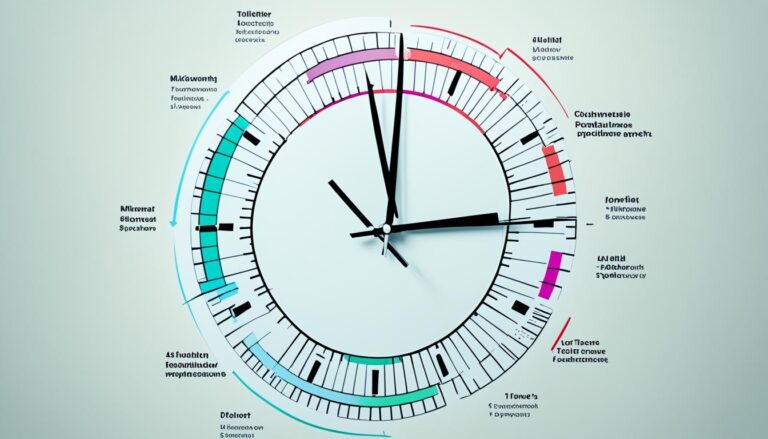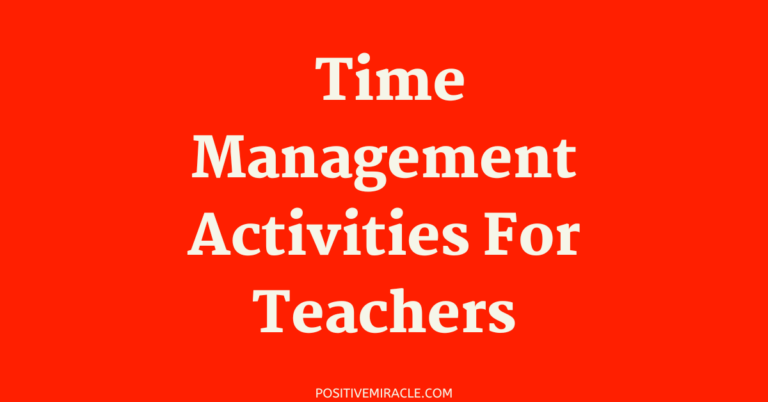Master Goal Setting and Time Management Today!

Are you struggling to achieve your goals? Feeling overwhelmed by the never-ending to-do list? It’s time to take control of your life and unlock your full potential through effective goal setting and time management. By mastering these essential skills, you can not only increase your productivity but also create a balanced and fulfilling lifestyle.
Setting smart goals and implementing effective time management strategies are the key to success in any endeavor. Whether you’re a student, professional, or entrepreneur, having a clear roadmap and the right tools can make all the difference in achieving your goals and maximizing your productivity. But where do you start? How can you effectively manage your time and set goals that will truly propel you forward?
In this article, we will explore goal achievement strategies, productivity tips, goal setting techniques, the time blocking method, prioritization skills, and goal tracking tools that will revolutionize your approach to goal setting and time management. Get ready to unleash your potential and make the most out of every moment!
Key Takeaways:
- Setting smart goals and managing your time effectively are integral to achieving success.
- By implementing goal achievement strategies and applying productivity tips, you can optimize your productivity.
- The time blocking method and prioritization skills help you focus on high-priority tasks.
- Goal tracking tools enable you to monitor your progress and stay on track.
- Mastering goal setting and time management can transform your life and lead to a balanced lifestyle.
The Benefits of Setting Time Management Goals
Setting time management goals offers numerous benefits that can significantly impact your productivity, well-being, and overall success. By proactively managing your time and setting goals, you can unlock your full potential and achieve a balanced and fulfilling lifestyle.
Reducing Stress
One of the key benefits of establishing time management goals is the tremendous reduction in stress levels. When you have clear goals and prioritize your tasks effectively, you gain a sense of control over your time and workload. This control helps you stay focused and organized, leading to a calmer and more productive work environment. By knowing exactly what needs to be done and when, you can approach your tasks with confidence and alleviate the anxiety associated with uncertainty and overwhelm.
Improving Decision-Making Skills
Effective time management goals provide you with clarity on what tasks are essential and align them with your personal and professional objectives. This clarity helps improve your decision-making skills as you can prioritize tasks based on their relevance and impact on your goals. By making informed choices about how to allocate your time and resources, you can make progress towards your objectives with purpose and intention.
Maximizing Resources
When you set time management goals, you prioritize tasks based on their importance and contribution to your overall goals. This approach enables you to maximize your resources, including time, energy, and effort. By focusing on high-priority activities that align with your objectives, you ensure that your valuable resources are invested in tasks that have the greatest impact. Consequently, you avoid wasting time and effort on non-essential activities or tasks that do not directly contribute to your goal achievement.
Achieving Work-Life Balance
Effective time management allows you to strike a healthy balance between work and personal life. When you establish time management goals, you allocate specific time slots for work responsibilities as well as for activities that nurture your well-being and relationships. This balanced approach helps prevent burnout and allows you to experience fulfillment in both professional and personal spheres. By managing your time effectively, you can dedicate quality time to your loved ones, hobbies, and self-care, leading to a more enriching and satisfying lifestyle.

Setting time management goals brings about a multitude of benefits, including reduced stress, improved decision-making skills, maximized resources, and achieved work-life balance. By incorporating effective time management practices into your daily life, you can optimize your productivity, enhance your well-being, and accomplish your goals with greater ease.
SMART Goals for Effective Time Management
When it comes to time management, setting goals is essential for staying focused and achieving success. However, not all goals are created equal. That’s where SMART goals come in. SMART is an acronym for Specific, Measurable, Achievable, Relevant, and Time-bound. By following these criteria, you can create goals that are clear, actionable, and aligned with your overall objectives.
Specific: Each goal should be well-defined and specific, leaving no room for ambiguity. Instead of setting a vague goal like “improve time management,” try setting a specific goal like “reduce time spent on non-essential tasks by 30%.”
Measurable: It’s important to be able to track your progress and determine whether you have achieved your goal. By making your goals measurable, you can quantify your progress and stay motivated. For example, instead of setting a goal to “be more organized,” set a goal to “complete daily to-do lists with an average completion rate of 90%.”
Achievable: Goals should be challenging yet attainable. Setting unrealistic goals can lead to frustration and burnout. Assess your capabilities and resources to ensure that your goals are within reach. For instance, if you have a heavy workload, setting a goal to “complete all tasks in a single day” may not be achievable. Instead, break it down and set a goal to “complete high-priority tasks by the end of each day.”
Relevant: Goals should align with your priorities and contribute to your overall success. Ensure that your goals are relevant to your personal or professional growth and support your long-term objectives. For instance, if your aim is to improve your professional skills, setting a goal to “enroll in at least one relevant online course per quarter” is both relevant and aligned with your aspirations.
Time-bound: Without specific timelines, goals tend to linger and lose their sense of urgency. Set deadlines for your goals to create a sense of accountability and drive. For example, instead of having a goal to “start a side project someday,” set a goal to “launch a viable side project within the next six months.”
By incorporating the principles of SMART goals into your time management strategy, you can set objectives that are clear, measurable, achievable, relevant, and time-bound. This framework enables you to prioritize your responsibilities, stay focused, and complete tasks in a timely and efficient manner. Remember, effective time management starts with setting SMART goals that align with your overarching objectives.
Task Prioritization for Effective Time Management
Prioritizing tasks is a critical aspect of effective time management. By organizing your tasks based on their importance and urgency, you can ensure that you are maximizing your productivity and making the most of your time. One popular method for task prioritization is the Eisenhower Matrix.
Eisenhower Matrix
The Eisenhower Matrix, also known as the Urgent-Important Matrix, helps you categorize tasks based on their urgency and importance. It divides tasks into four quadrants:
| Urgent and Important | Important but Not Urgent |
|---|---|
| These tasks require immediate attention and should be done as soon as possible. They are crucial for achieving your goals and meeting deadlines. | These tasks are important for your long-term goals but do not require immediate action. They can be scheduled and worked on strategically. |
| Urgent but Not Important | Not Urgent and Not Important |
| These tasks may seem urgent, but they do not contribute significantly to your goals. Delegate or eliminate them whenever possible. | These tasks are time-wasters and should be avoided. They provide little value to your work or personal life. |
The Eisenhower Matrix helps you visualize your tasks and make informed decisions about how to allocate your time and resources. By focusing on tasks that are both urgent and important, you can ensure that key deadlines are met while considering your overall organizational goals.
Effective task prioritization is about finding the right balance between urgency and importance. It ensures that important tasks are not overlooked or delayed and helps you stay on track with your goals and objectives.

Overcoming Procrastination in Time Management
Procrastination can be a major roadblock to effective time management. It’s easy to get caught up in distractions and delay important tasks, but there are strategies you can implement to overcome this challenge and boost your productivity.
Setting Time Limits
One effective way to combat procrastination is by setting specific time limits for each task. By allocating a fixed amount of time to complete a task, you create a sense of urgency and minimize the tendency to put it off. Use timers or productivity apps to track your progress and hold yourself accountable.
Task Breakdown
Large, daunting tasks often contribute to procrastination. Break them down into smaller, more manageable subtasks to make them feel less overwhelming. This approach not only makes the task seem more achievable but also provides a sense of accomplishment as you complete each subtask.
Time Tracking
Understanding how you spend your time is crucial in identifying areas where you may be prone to procrastination. Utilize time tracking tools or apps to monitor your activities throughout the day. This valuable data will help you gain insights into your productivity patterns and identify opportunities for improvement.
Rewards for Achievements
Research shows that rewards can be powerful motivators. Consider implementing a reward system for yourself, where you treat yourself after completing a task or achieving a milestone. It could be anything that brings you joy, like indulging in your favorite snack, taking a short break, or treating yourself to a relaxing activity.
Avoiding Distractions
Distractions can derail your focus and contribute to procrastination. Create boundaries by turning off notifications on your devices and designating specific times for checking emails and social media. Optimize your environment for concentration by finding a quiet workspace or using noise-canceling headphones to block out any external disturbances.
By implementing these strategies, you can overcome procrastination and maximize your time management efforts. Take control of your productivity and stay on track towards achieving your goals.
| Strategies to Overcome Procrastination | Benefits |
|---|---|
| Setting Time Limits | Creates a sense of urgency and minimizes procrastination |
| Task Breakdown | Makes tasks more manageable and increases motivation |
| Time Tracking | Identifies areas of procrastination and opportunities for improvement |
| Rewards for Achievements | Motivates and provides a sense of accomplishment |
| Avoiding Distractions | Improves focus and minimizes time wasted on unproductive activities |

Managing Distractions for Effective Time Management
Managing distractions is crucial for effective time management. To stay focused on your tasks, it’s essential to implement strategies that minimize interruptions and create an environment conducive to productivity. By incorporating the following techniques, you can better manage distractions and make the most of your time.
1. Turning Off Notifications
Distraction management starts with disabling unnecessary notifications. Constant alerts from emails, social media, and messaging apps can derail your focus and disrupt your workflow. Silence or turn off notifications during dedicated work periods to avoid interruptions and maintain concentration. Set specific times to check and respond to messages, and free yourself from the constant urge to react immediately.
2. Limiting Email and Social Media Usage
Email and social media platforms can easily consume significant chunks of your time. Create boundaries by designating specific windows for checking and responding to emails. Similarly, allocate dedicated breaks to engage with social media, ensuring they don’t encroach upon your working hours. By setting limits, you can prevent these platforms from becoming endless sources of distraction and maintain a more focused approach to your tasks.
3. Creating a Quiet Workspace
A quiet workspace minimizes external disturbances and promotes concentration. Designate a specific area in your home or office where you can work without being easily interrupted. Arrange your workspace in a way that minimizes distractions, keeps necessary materials within reach, and creates a productive atmosphere. A well-organized and quiet environment can greatly enhance your ability to stay focused and accomplish your tasks efficiently.
| Noise-canceling Headphones Comparison | |
|---|---|
| Brand | Features |
| Sony WH-1000XM4 | Industry-leading noise cancellation, long battery life, touch controls, voice assistant compatibility |
| Bose QuietComfort 35 II | Excellent noise cancellation, comfortable fit, built-in microphone, Alexa-enabled |
| Jabra Elite 85h | SmartSound technology, customizable sound profiles, up to 36 hours of battery life |
4. Noise-canceling Headphones
Noise-canceling headphones can effectively block out external sounds, helping you concentrate on your tasks. These headphones use advanced technology to reduce ambient noise, allowing you to create a cocoon of focus wherever you are. They are particularly beneficial in open office environments or when working remotely in noisy surroundings. With noise-canceling headphones, you can create an auditory barrier that facilitates deep concentration and mitigates distractions.

5. Utilizing Technology Tools
Take advantage of technology to manage distractions and improve your productivity. Consider using notification blockers or productivity apps that can limit access to distracting websites or silence notifications during specific time blocks. These tools can help you establish discipline, develop self-control, and maintain focus on your tasks, contributing to effective time management.
By implementing these strategies, you can effectively manage distractions and optimize your time. Remember, distractions are inevitable, but with the right techniques, you can develop the discipline and focus needed to stay productive.
Multitasking and Time Management
Multitasking can be challenging, but with the right tools and techniques, it can be managed effectively. Visual tools such as Gantt Charts, Kanban Boards, and mind maps can greatly assist in multitasking and time management. These tools provide a visual representation of tasks, enabling you to track progress and manage project timelines efficiently.
Gantt Charts are excellent for planning and scheduling tasks, allowing you to visualize the start and end dates of each task. Kanban Boards offer a flexible way of organizing tasks, making it easy to prioritize and allocate your time effectively. Mind maps provide a holistic view of a project, helping you brainstorm ideas and break down complex tasks into manageable subtasks.
By breaking down complex projects into smaller tasks and utilizing asynchronous updates, you can simplify multitasking. This approach ensures that each task is given the necessary time and attention without feeling overwhelmed. Asynchronous updates allow team members to work on different aspects of a project at their own pace, increasing efficiency and collaboration.
Visual tools not only enhance productivity but also provide clarity and organization. They enable you to manage multiple projects simultaneously, ensuring that nothing falls through the cracks. With Gantt Charts, Kanban Boards, and mind maps, you can stay on track and achieve your goals efficiently.
Conclusion
In conclusion, mastering goal setting and time management is crucial for achieving success and increasing productivity in your personal and professional life. By implementing effective time management techniques such as setting SMART goals, prioritizing tasks, and managing distractions, you can optimize your time and resources.
When you set SMART goals, you define specific objectives that are measurable, achievable, relevant, and time-bound. This helps you stay on track, prioritize responsibilities, and complete tasks efficiently. By prioritizing tasks using strategies like the Eisenhower Matrix, you ensure that you focus on what’s important and urgent, maximizing your productivity.
Additionally, effective time management techniques enable you to balance your work and personal life, leading to a more fulfilling and balanced lifestyle. By managing distractions, turning off notifications, and creating a quiet workspace, you can stay focused and minimize wasted time.
By harnessing the power of goal setting and time management, you can unlock your full potential and achieve your desired goals. So start implementing these effective time management techniques today and watch as your productivity soars, your balance improves, and your goals become a reality.
FAQ
What are the benefits of setting time management goals?
Setting time management goals reduces stress, improves decision-making skills, maximizes resources, and fosters a healthy work-life balance.
What are SMART goals and how do they relate to time management?
SMART goals are Specific, Measurable, Achievable, Relevant, and Time-bound goals. They help individuals prioritize responsibilities, stay on track, and complete tasks in a timely and efficient manner.
How can I prioritize tasks effectively?
Task prioritization can be done using the Eisenhower Matrix, which helps individuals categorize tasks into urgent and important categories and make informed decisions about how to allocate their time and resources.
How can I overcome procrastination in time management?
Overcoming procrastination can be achieved by setting specific time limits for tasks, breaking down larger tasks into smaller subtasks, tracking time spent on tasks, providing rewards for completion, and managing distractions.
What are some effective strategies for managing distractions?
Managing distractions involves turning off notifications, limiting email and social media usage, creating a quiet workspace, and using noise-canceling headphones to block out external distractions.
How can visual tools help with multitasking and time management?
Visual tools like Gantt Charts, Kanban Boards, and mind maps provide clarity, help individuals track progress, and manage project timelines, making multitasking more manageable and ensuring that each task receives the necessary time and attention.






